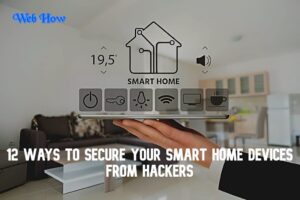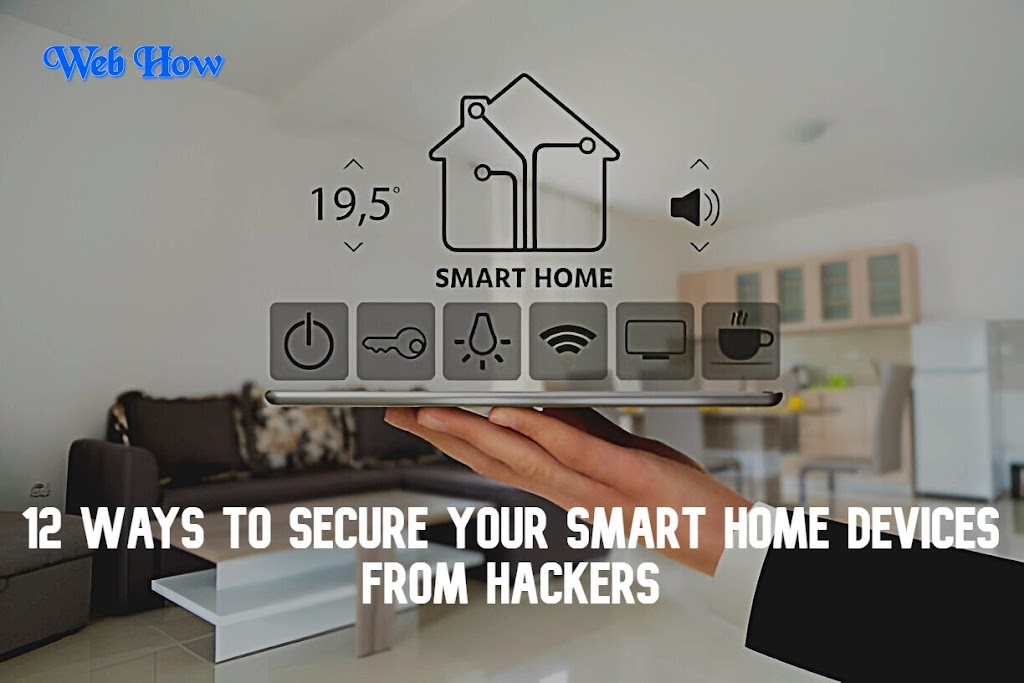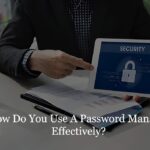12 Ways to Secure Your Smart Home Devices From Hackers IoT Safety:
1. Secure Your Network
The first line of defense for your smart home devices is a secure network. Here are some steps to fortify your network security:
 |
| How To |
a. Use Strong Passwords
Ensure your Wi-Fi network has a robust password. Steer clear of employing terms, phrases, or information that is simple to figure out. Instead, create a complex password with a mix of letters (both upper and lower case), numbers, and special characters. Additionally, change the default login credentials on your router to something unique.
b. Enable Network Encryption
Enable WPA3 encryption on your router if available, as it provides the highest level of security. If WPA3 is not an option, WPA2 is a suitable alternative. Encryption helps protect the data transmitted between your devices and your network.
c. Set Up a Guest Network
Consider setting up a separate guest network for your IoT devices. This isolates them from your main network, adding an extra layer of security. If a device on the guest network is compromised, it won’t affect the devices on your primary network.
2. Keep Firmware and Software Updated
Manufacturers regularly release firmware and software updates to fix security vulnerabilities and improve functionality. Here’s what you need to do:
a. Enable Automatic Updates
Whenever possible, enable automatic updates for your smart home devices. By doing this, you can be sure that you always have the newest features and security patches.
b. Regularly Check for Updates
For devices that don’t support automatic updates, manually check for updates periodically. Visit the manufacturer’s website or use the device’s companion app to see if any updates are available.
3. Use Strong, Unique Passwords for Each Device
Each smart home device should have its own unique password. Using the same password across multiple devices increases the risk of a security breach. Consider using a password manager to keep track of all your passwords and generate strong, unique ones.
4. Enable Two-Factor Authentication (2FA)
Two-factor authentication adds an extra layer of security by requiring not just a password but also a second form of verification, such as a code sent to your phone. Enable 2FA on your smart home devices and related accounts whenever possible. Hackers will find it far more difficult to obtain illegal access as a result.
5. Disable Unnecessary Features
Many smart devices come with features that you may not need. These features can sometimes introduce security vulnerabilities. Here are some tips:
a. Disable Remote Access
Unless you specifically need to access your devices remotely, disable this feature. Remote access can be a gateway for hackers.
b. Turn Off Features Not in Use
Features like voice control, location tracking, or automatic connections may not always be necessary. Review the settings on your devices and turn off any features that are not essential.
6. Monitor Device Activity
Keeping an eye on the activity of your smart devices can help you detect unusual behavior that might indicate a security issue. Here’s how:
a. Use Network Monitoring Tools
There are various tools and apps available that can help you monitor your network traffic. These tools can alert you to unusual activity, such as a device communicating with unknown servers.
b. Regularly Check Device Logs
Some smart devices provide logs that track their activity. Reviewing these logs can help you spot any anomalies that might indicate a security breach.
7. Implement Firewalls and VPNs
a. Use a Firewall
Firewalls act as barriers between your devices and potential threats from the internet. Most routers come with built-in firewall features that you should enable. Additionally, consider using a software firewall on your individual devices for added protection.
b. Utilize a VPN
A Virtual Private Network (VPN) encrypts your internet traffic, making it harder for hackers to intercept your data. Using a VPN can provide an additional layer of security, especially when accessing your smart home devices remotely.
8. Educate Yourself and Your Family
Security is a shared responsibility. Make sure everyone in your household understands the importance of smart home security and follows best practices:
a. Create Strong Passwords
Educate family members on creating and maintaining strong, unique passwords for their accounts and devices.
b. Recognize Phishing Scams
Teach your family about common phishing tactics and how to recognize suspicious emails, messages, or websites.
c. Safe Internet Practices
Encourage safe internet practices, such as not clicking on unknown links, downloading files from trusted sources only, and regularly updating software.
9. Invest in Reputable Brands and Devices
Not all smart home devices are created equal. When choosing devices, consider the following:
a. Research Brands
Invest in devices from reputable brands known for their security standards. Read reviews and check if the brand regularly updates its firmware.
b. Look for Security Certifications
Some devices come with security certifications that indicate they have been tested and meet certain security standards. Look for certifications such as IoT Security Foundation or UL 2900.
10. Regularly Audit Your Devices
Conduct regular audits of your smart home ecosystem to ensure everything is secure:
a. Inventory Your Devices
Keep an up-to-date inventory of all your smart home devices. This helps you track what’s connected to your network and ensures no unauthorized devices are present.
b. Review Security Settings
Periodically review the security settings on all your devices. Make sure they comply with the latest best practices and adjust any settings as necessary.
11. Be Cautious with Third-Party Integrations
Many smart home devices offer integrations with third-party services. While these can enhance functionality, they also introduce additional security risks:
a. Limit Third-Party Access
Only integrate third-party services that you trust and are necessary for your setup. Review the permissions granted to these services and limit access to only what is needed.
b. Regularly Review Integrations
Regularly review and update the list of third-party integrations. Remove any services that you no longer use or trust.
12. Backup Your Data
Backing up your data can help you recover quickly in case of a security breach. Here’s how to do it effectively:
a. Use Encrypted Backups
Ensure that your backups are encrypted. This adds a layer of security and protects your data from unauthorized access.
b. Store Backups Securely
Store your backups in a secure location, such as an external hard drive kept in a safe place or a reputable cloud storage service with strong security measures.
FAQs(Frequently Asked Questions):
1. Why is securing smart home devices important?
Securing smart home devices is crucial because they are connected to your home network and can be vulnerable to cyberattacks. A breach can lead to unauthorized access to your personal data, privacy invasion, and even control over your devices, which can compromise your safety and security.
2. What is the first step in securing my smart home devices?
The first step is to secure your home network. This includes using a strong, unique password for your Wi-Fi, enabling network encryption (preferably WPA3), and setting up a separate guest network for your IoT devices.
3. How often should I update the firmware and software of my devices?
You should enable automatic updates whenever possible to ensure your devices always have the latest security patches. For devices that do not support automatic updates, manually check for updates periodically, ideally every month.
4. What makes a password strong and secure?
A strong password is typically at least 12 characters long and includes a mix of upper and lower case letters, numbers, and special characters. Steer clear of utilizing well-known words, phrases, or information that may be guessed, such as names or birthdays.
5. What is two-factor authentication (2FA) and why should I use it?
Two-factor authentication adds an extra layer of security by requiring two forms of verification: something you know (a password) and something you have (like a code sent to your phone).This considerably increases the difficulty for hackers to access your accounts without authorization.
6. Are there any features I should disable on my smart devices?
Yes, you should disable any features that you do not use, such as remote access, voice control, or location tracking. These features can introduce security vulnerabilities if left enabled unnecessarily.
7. What tools can I use to monitor my smart home network for suspicious activity?
There are various network monitoring tools and apps available, such as Fing, GlassWire, and Norton Core. These tools can alert you to unusual activity and help you monitor the devices connected to your network.
8. How can a firewall and VPN enhance my smart home security?
A firewall acts as a barrier between your devices and potential online threats, while a VPN encrypts your internet traffic, making it harder for hackers to intercept your data. Both can provide additional layers of security for your smart home network.
9. Why should I invest in reputable brands for my smart home devices?
Reputable brands are more likely to adhere to higher security standards and provide regular firmware updates to address vulnerabilities. Researching brands and choosing devices with security certifications can help ensure you are using reliable and secure products.
10. What is the purpose of conducting regular audits of my smart home devices?
Regular audits help you keep track of all connected devices, ensure they have the latest security settings, and remove any unauthorized or unnecessary devices from your network. This ongoing process helps maintain a secure smart home environment.
11. Should I be cautious with third-party integrations on my smart devices?
Yes, while third-party integrations can enhance functionality, they can also introduce security risks. Only use trusted third-party services and regularly review and update the permissions and integrations to limit potential vulnerabilities.
12. How can I safely back up my smart home data?
Use encrypted backups to protect your data from unauthorized access. Store backups in secure locations, such as an external hard drive kept in a safe place or a reputable cloud storage service with strong security measures.
13. What should I do if I suspect a security breach on one of my smart devices?
If you suspect a security breach, immediately disconnect the affected device from your network. Change all related passwords, check for firmware updates, and review the device’s security settings. Consider consulting a professional if you need further assistance.
14. How can I educate my family about smart home security?
Educate your family by discussing the importance of creating strong passwords, recognizing phishing scams, and practicing safe internet habits. Encourage them to stay informed about the latest security practices and to follow best practices for device and network security.
15. Can smart home devices be hacked even with security measures in place?
While no system is completely immune to hacking, following best practices significantly reduces the risk. Regular updates, strong passwords, 2FA, and network security measures make it much harder for hackers to breach your smart home devices.
Conclusion
Securing your smart home devices is an ongoing process that requires diligence and proactive measures. By following these tech tips, you can significantly enhance your IoT safety and protect your home from cyber threats. Remember, the convenience of smart technology should not come at the expense of security. Regularly update your devices, use strong passwords, enable two-factor authentication, and stay informed about the latest security practices. By taking these steps, you can enjoy the benefits of a smart home while keeping your data and privacy safe.


